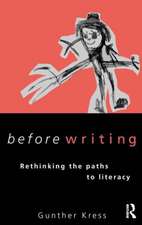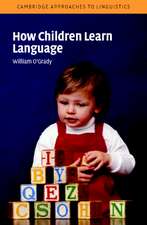The Fluency Construct: Curriculum-Based Measurement Concepts and Applications
Editat de Kelli D. Cummings, Yaacov Petscheren Limba Engleză Paperback – 10 ian 2017
Included in the coverage:
- Indicators of fluent writing in beginning writers.
- Fluency in language acquisition, reading, and mathematics.
- Foundations of fluency-based assessmentsin behavioral and psychometric paradigms.
- Using response time and accuracy data to inform the measurement of fluency.
- Using individual growth curves to model reading fluency.
- Latent class analysis for reading fluency research.
| Toate formatele și edițiile | Preț | Express |
|---|---|---|
| Paperback (1) | 387.23 lei 39-44 zile | |
| Springer – 10 ian 2017 | 387.23 lei 39-44 zile | |
| Hardback (1) | 394.89 lei 6-8 săpt. | |
| Springer – 12 dec 2015 | 394.89 lei 6-8 săpt. |
Preț: 387.23 lei
Nou
Puncte Express: 581
Preț estimativ în valută:
74.15€ • 76.49$ • 61.45£
74.15€ • 76.49$ • 61.45£
Carte tipărită la comandă
Livrare economică 17-22 februarie
Preluare comenzi: 021 569.72.76
Specificații
ISBN-13: 9781493969227
ISBN-10: 1493969226
Pagini: 386
Ilustrații: XIV, 386 p. 57 illus.
Dimensiuni: 155 x 235 mm
Greutate: 0.76 kg
Ediția:1st ed. 2016
Editura: Springer
Colecția Springer
Locul publicării:New York, NY, United States
ISBN-10: 1493969226
Pagini: 386
Ilustrații: XIV, 386 p. 57 illus.
Dimensiuni: 155 x 235 mm
Greutate: 0.76 kg
Ediția:1st ed. 2016
Editura: Springer
Colecția Springer
Locul publicării:New York, NY, United States
Cuprins
Preface.- Chapter 1. What is Fluency?; Gina Biancarosa and Lina Shanley.- SECTION ONE: Applied Use of Fluency Measures.- Chapter 2. Indicators of Fluent Writing in Beginning Writers; Kristen D. Ritchey, Kristen L. McMaster, Stephanie Al Otaiba, Cynthia S. Puranik, Young-Suk, Kim, David C. Parker, Miriam Ortiz.- Chapter 3. Mathematics Fluency—More than the Weekly Timed Test; Ben Clarke, Nancy Nelson, Lina Shanley.- Chapter 4. Using Curriculum-Based Measurement Fluency Data for Initial Screening Decisions; Erica S. Lembke, Abigail Carlisle, Apryl Poch.- Chapter 5. Using Oral Reading Fluency to Evaluate Response to Intervention and to Identify Students not Making Sufficient Progress; Matthew K. Burns, Benjamin Silberglitt, Theodore J. Christ, Kimberly A. Gibbons, Melissa Coolong-Chaffin.- SECTION TWO: Considerations for Test Development.- Chapter 6. Foundations of Fluency-Based Assessments in Behavioral and Psychometric Paradigms; Theodore J. Christ, Ethan R. Van Norman, Peter M. Nelson.- Chapter 7. Using Response Time and Accuracy Data to Inform the Measurement of Fluency; John Prindle, Alison M. Mitchell, Yaacov Petscher.- Chapter 8. An Introduction to the Statistical Evaluation of Fluency Measures with Signal Detection Theory; Keith Smolkowski and Kelli D. Cummings.- Chapter 9. Different Approaches to Equating Oral Reading Fluency Passages; Kristi L. Santi, Christopher Barr, Shiva Khalaf, David J. Francis.- SECTION THREE: Advanced Research Methods.- Chapter 10. Using Individual Growth Curves to Model Reading Fluency; D. Betsy McCoach and Huihui Yu.- Chapter 11. Introduction to Latent Class Analysis for Reading Fluency Research; Jessica A.R. Logan and Jill M. Pentimonti.- Chapter 12. Using Latent Change Score Analysis to Model Growth and Causality in Fluency Skills; Yaacov Petscher, Sharon Koon, Sarah Herrera.- Chapter 13. Conclusion: Oral Reading
Fluency or Reading Aloud from Text: An Analysis through a Unified View of Construct Validity; Christine A. Espin and Stanley L. Deno.
Fluency or Reading Aloud from Text: An Analysis through a Unified View of Construct Validity; Christine A. Espin and Stanley L. Deno.
Notă biografică
Kelli D. Cummings, Ph.D., NCSP, is an Assistant Professor at the University of Maryland. Her research focuses on projects that link assessment and intervention technologies to improve student success. She has worked as a special education teacher, a school psychologist and a trainer of school psychologists; she brings these practical experiences to her work in the research community. Dr. Cummings has provided formal technical assistance and training on Problem-Solving, Response-to-Intervention and the use of Curriculum-Based Measurement for data-based decision making in schools throughout the U.S., Canada, and Great Britain. Her work is published regularly in school psychology and education journals.
Yaacov Petscher, Ph.D., is the Director of Research at the Florida Center for Reading Research at Florida State University. His research interests are in the areas of computer adaptive assessments, the study of individual differences in reading, psychometrics and applied research methods in education. Dr. Petscher recently edited Applied Quantitative Analysis in Education and the Social Sciences and regularly publishes in education, psychology and measurement journals as well as technical reports for the National Center for Education Evaluation and Regional Assistance via the Regional Educational Laboratory – Southeast.
Yaacov Petscher, Ph.D., is the Director of Research at the Florida Center for Reading Research at Florida State University. His research interests are in the areas of computer adaptive assessments, the study of individual differences in reading, psychometrics and applied research methods in education. Dr. Petscher recently edited Applied Quantitative Analysis in Education and the Social Sciences and regularly publishes in education, psychology and measurement journals as well as technical reports for the National Center for Education Evaluation and Regional Assistance via the Regional Educational Laboratory – Southeast.
Textul de pe ultima copertă
This book provides a comprehensive overview of fluency as a construct and its assessment in the context of curriculum-based measurement (CBM). Comparing perspectives from language acquisition, reading, and mathematics, the book parses the vagueness and complexities surrounding fluency concepts and their resulting impact on testing, intervention, and students' educational development. Applications of this knowledge in screening and testing, ideas for creating more targeted measures, and advanced methods for studying fluency data demonstrate the overall salience of fluency within CBM. Throughout, contributors argue for greater specificity and nuance in isolating skills to be measured and improved, and for terminology that reflects those educational benchmarks.
Included in the coverage:
Included in the coverage:
- Indicators of fluent writing in beginning writers.
- Fluency in language acquisition, reading, and mathematics.
- Foundations of fluency-based assessmentsin behavioral and psychometric paradigms.
- Using response time and accuracy data to inform the measurement of fluency.
- Using individual growth curves to model reading fluency.
- Latent class analysis for reading fluency research.
Caracteristici
Provides a comprehensive overview of fluency as a construct Paints a picture of the construct that is nuanced and relevant enough for the myriad decisions that fluency data are intended to facilitate Lays a foundation for future fluency and measurement research Brings together current information on measurement properties of fluency assessments into one resource Includes supplementary material: sn.pub/extras


















